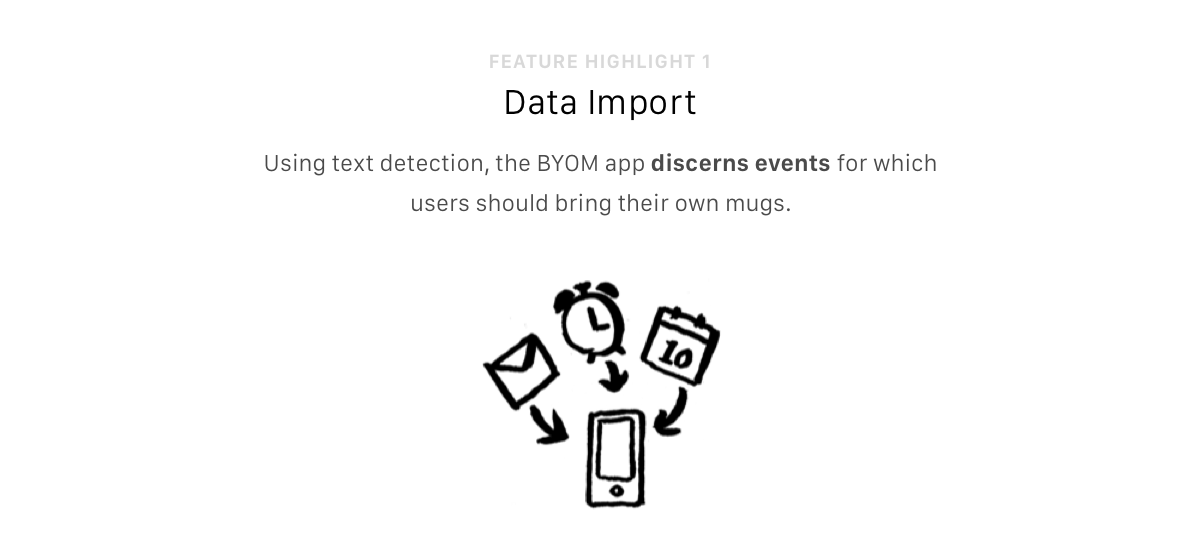

How do we motivate students to adopt green behavior — using reusable mugs to reduce waste?
Many campus events provide free drinks, all with disposable cups. Those cups go right into landfills after being used once. In the U.S., the average college student creates 640 pounds of solid waste per year, including nearly 500 disposable cups. Using and tossing single-use cups is convenient. However, if each person takes disposable cups for granted, disregarding the environmental costs, the ecological impact can be huge.

To address this environmental issue, we leveraged mobile and pervasive design to create Bring Your Own Mug (BYOM). The BYOM system consists of a mobile app, as well as a smart sleeve that communicates with the app.

The system helps individuals track their successful mug usage, translating it into factual measurements and individual achievements. Through the social system, users build up eco-friendly communities, viewing their friends’ usage and the networks’ collective environmental impact.
The sleeve slips onto mugs of different shapes and sizes, and syncs with the app via Bluetooth. The bottle orientation with squeeze sensitivity, measured by gyroscope and force-sensitive resistor sensor fusion, approximates when the bottle is in use. The auto-sync feature relieves users from manual data entry, increasing both tracking validity and accountability.

We consulted Chuan-Che Huang (Ph.D candidate with a focus on HCI and Context-aware Computing) to determine which sensors could detect relevant information while keeping the cost low and battery life long. This sleek product can be manufactured in a range of colors to match personal style. Additionally, the physical product draws visibility to the initiative, encouraging others to join BYOM.


The app syncs with the user’s native calendar or iCal. Using text detection, the BYOM app discerns events for which users should bring their own mugs. This relieves users from setting manual reminders, and reads carefully over event details, which users may have only skimmed.

To prompt the user to bring their mugs and avoid sending ill-timed notifications as much as possible, the sensor and the reminder will only start functioning after the last morning alarm on the user’s phone. The phone serves as a proxy for the user’s location. If the distance between the device and the mug exceeds the setting range, BYOM will send a reminder to users’ phones.

A tree graphic visualizes the user’s accumulated usage. It grows to indicate successful usage, and shrinks if the user is located at the event without using a BYOM-equipped mug. The app also shows factual measurements of the amount of water, and CO2 that the user has saved by foregoing one-time cups.

The environmental impact is greater when people work together. The users can see friends’ usage and contribution at any time. The community record increases accountability, motivating continued use.
I shout "GO BLUE" for my school pride; I say "GO GREEN" when it comes to lifestyle changes. Environmental issues are dear to my heart. I use reusable containers and utensils to reduce waste I generate in my daily life, and I have been trying to influence people around me to practice a more eco-friendly lifestyle.

As a problem-solving designer and a green enthusiast, I wanted to create a bigger impact through design. I brought the project idea to my team, hoping to leverage user-centered design to elicit eco-friendly awareness and behavior. In one-sentence statement, our design problem was:
How might we design to cultivate environmental awareness in people and change their waste behavior?
To understand the problem space and specify our focus, we conducted background research and experts/stakeholder consultations. We read policies/regulations in the U.S., reports, news articles, and other sources to understand today's trash crisis.
